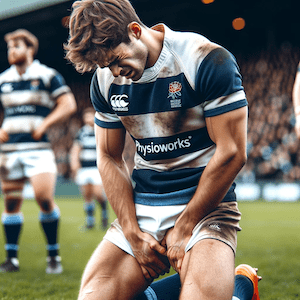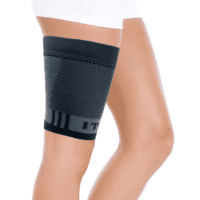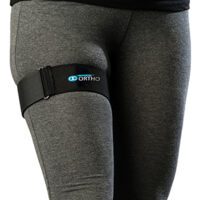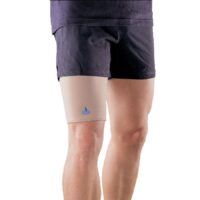
Groin Strain
Insights from Physiotherapists
When you come to us with groin pain, it’s often due to a groin strain—a condition we commonly address in our practice. As physiotherapists, we’re committed to providing clarity and care for this ailment.
What Constitutes a Groin Strain?
A groin strain arises from an overstretched or torn muscle in the groin area, typically affecting one of the hip adductor muscle groups. The five adductor muscles include the adductor brevis, longus, magnus, pectineus, and gracilis, with the adductor longus being the frequent culprit. Such injuries are prevalent in activities demanding speed, agility, and force, such as kicking or sprinting.
Symptoms That Shouldn’t Be Ignored
- Groin pain that’s sharp and localised
- Muscle tightness or spasm within the groin
- Pain upon stretching the groin muscles
- Discomfort during activities that contract the groin muscles, like squeezing the thighs together
Our Approach to Diagnosis
Properly diagnosing the cause of groin pain is crucial. While the pain is often related to a muscle strain, hernias, and other conditions can present similarly. We conduct detailed physical examinations to determine the source of the pain. Should a hernia be a concern, we’ll recommend a consultation with a surgeon specialising in groin issues. Tools such as MRI and ultrasound can further aid in pinpointing the injury’s specifics.
Grading the Severity: A Physiotherapist’s Perspective
- Grade 1 Strain: Mild with minimal disruption to daily activities
- Grade 2 Strain: Moderate, possibly impacting sports performance and ambulation
- Grade 3 Strain: Severe, affecting running, jumping, and hopping, potentially requiring surgical intervention
Even after initial recovery, issues like inflammation or tendinopathy can persist, necessitating ongoing management.
Advances in Groin Strain Management
In line with the latest research, we advocate for a proactive rehabilitation approach. This encompasses early movement, targeted strength training, and exercises that resonate with your level of activity and sport.
Crafting Your Path to Recovery
Our treatment philosophy revolves around a personalised plan, initiated with an accurate assessment. With our collective experience in managing both traumatic and biomechanical groin injuries, we craft a recovery program tailored just for you, aiming to alleviate symptoms and tackle the underlying cause.
With early intervention, most groin strains respond well to physiotherapy interventions such as:
- Manual therapy techniques
- Customised strengthening and stability exercises
- Preventative and educational strategies
A Unified Call to Action
Groin strains are intricate, and without professional intervention, they can lead to extended discomfort or more serious injury. It’s crucial to consult with sports physiotherapists like us—professionals experienced in diagnosing and managing groin pain.
For anyone suffering from a groin strain, our advice is unified: don’t wait. Reach out to us for a thorough assessment and a tailored, research-backed treatment plan. Together, we’ll work towards overcoming the pain and returning you to your active life quickly and effectively.
In wrapping up, it’s important to understand the complexities surrounding a groin strain. With our combined expertise, we’re confident in guiding you through a successful recovery. Remember, a groin strain is a challenge we can face together. Take the proactive step—book a consultation with us today and stride towards recovery.
Rochedale - Call 38410277
Book Online: RochedaleSalisbury - Call 32751044
Book Online: SalisburySandgate - Call 32691122
Book Online: SandgateRelated Articles
- Hip Flexor: Iliopsoas Groin Pain: Causes And Treatment: This article discusses various types of groin pain, including adductor-related groin pain, osteitis pubis, and iliopsoas-related groin pain. It also covers other muscle-related pains and systemic diseases affecting the hip.
- Groin Pain Management: Physiotherapist Advice: Offers guidance on managing hip and groin pain through tailored exercise programs and the importance of consulting with a physiotherapist for a personalised treatment plan.
- Hip Adductor Tendinopathy – Effective Physio Solutions: Explores different types of groin pain, including adductor-related groin pain, and emphasises the significance of exercise programs in managing pain.
- Osteitis Pubis: Provides an overview of osteitis pubis, a common cause of chronic groin pain, and discusses its treatment and management.
- FAIS – Hip & Groin Pain Guide: Offers a comprehensive guide on causes, treatment, and advice for hip and groin pain, highlighting the importance of professional advice and tailored exercise programs.
































































